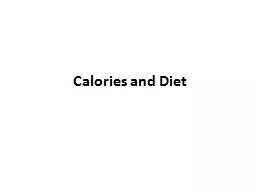

people are counting them and cutting them supermarkets are filled with packaging that has calories on the label What is a Calorie calorie is a unit of energy Specific definition is a ID: 739955
Download Presentation The PPT/PDF document "Calories and Diet What exactly is a cal..." is the property of its rightful owner. Permission is granted to download and print the materials on this web site for personal, non-commercial use only, and to display it on your personal computer provided you do not modify the materials and that you retain all copyright notices contained in the materials. By downloading content from our website, you accept the terms of this agreement.
Slide1
Calories and DietSlide2
What exactly is a calorie?
--
people are counting them and cutting them
,
--- supermarkets are filled with packaging that has calories on the label.Slide3
What is a Calorie?
calorie is a
unit of energy.
Specific definition is “a
calorie is the amount of energy, or
heat, it takes to raise the temperature of 1 gram of water 1 degree
Celsius”.
One calorie is equal to 4.184 joules
We associate
calories with food, but they apply to anything containing energy.
For
example, a gallon (about 4 liters) of gasoline contains about 31,000,000 calories. Slide4
DID YOU KNOW?
the
calories on a food package are actually kilocalories (1,000 calories = 1 kilocalorie)
lower
case
“c”
means
calories
kilocalories
is
represented by a upper case
“C
”.
BUT on labelling it is not always used instead “food calories means kilocalories”
A
can of soda with 200 food calories contains 200,000 regular calories, or 200 kilocalories.
The same applies to exercise -- when a fitness chart says you burn about 100 calories for every mile you jog, it means 100 kilocalories.
For the rest of this presentation
a calorie represents one kilocalorieSlide5
What Calories
Do:
Caloric Breakdown1 g Carbohydrates: 4
Kilo
calories
1
g Protein: 4
Kilo
calories
1
g Fat: 9
Kilo
calories
Slide6
Human beings need energy to survive
EXAMPLE: A package of
maple-and-brown-sugar oatmeal contains 160
k
calories
.
This means that if we were to pour this oatmeal into a dish, set the oatmeal on fire and get it to burn completely (which is actually pretty tricky
).
the
reaction would produce 160
kilocalories --
enough energy to raise the temperature of 160 kilograms of water 1 degree Celsius.
If we look closer at the nutritional label, we see that our oatmeal
has:
2
grams of
fat
(9
k
cal X 2 g)
4
grams of protein
(4
k
cal X 4 g)
32
grams of
carbohydrates (4
k
cal X 32 g),
a
total of 162
k
calories
(the total is rounded on packaging)Slide7
Your Caloric Needs
There
are three main factors involved in calculating how many calories your body needs per day:
your BMR (Basal Metabolic Rate),
physical
activity
and
the
thermic effect of
food
(this is the amount of energy your body uses to digest the food you eat)
To
calculate the number of calories you expend in this process, multiply the total number of calories you eat in a day by 0.10, or 10 percent.
The total number of calories a body needs in a day is the sum of these three calculations. Slide8
BMR: Basal Metabolic Rate
Your basal metabolic rate (BMR) is the amount of energy your body needs to function at rest.
This accounts for about 60 to 70 percent of calories burned in a day
includes
the energy required to keep the heart beating, the lungs breathing, the kidneys functioning and the body temperature stabilized. Slide9
BMR: Male and Female
In general, men have a higher BMR than women. One of the most accurate methods of estimating your basal metabolic rate is the
Harris-Benedict formula: Adult male: [
66
+
(13.7
x
mass in kilograms)
+
(5.0
x height in
centrimeters
)
- (6.8 x age in years)
] X 4.18
Adult female:
[655
+
(9.6
x
mass in kilograms)
+
(1.8
x height in
centrimeters
)
- (4.7 x age in years
)] X 4.18 Slide10
Just how many calories do our cells need to function well?
The
number is different for every person.You
may notice on the nutritional labels of the foods you buy that the "
percent daily values
" are based on a
2,000
Calorie
diet
2,000
C
alories
is a rough average of what a person needs to eat in a day, but your body might need more or less than 2,000
Calories
.
Height, weight, gender, age and activity level all affect your caloric needs. Slide11
Here are some calorie and fat contents that may surprise you:
Food
Serving Size
Calories
Fat Gram
Canola
oil
1 cup
1 674
218
Peanut butter
1 cup
1 520
129
Cheddar cheese
1 cup
531
44
Granola
1 cup
270
8Chocolate syrup1 cup8373Sugar1 cup7740Coca-cola1 can1400
Excerpted & edited from http://health.howstuffworks.com/wellness/diet-fitness/weight-loss/calorie5.htm Slide12
Calories, Fat and Exercise
So what happens if you take in more or fewer calories than your body burns?
You either gain or lose fat, respectively.
One
thing about exercise is that it raises your metabolic rate
during exercise and for
about two hours
after you've stopped exercising.
a
calorie is a
calorie
(it doesn’t matter where it comes from – carbs, fats, proteins)
As long as you burn what you eat, you will maintain your weight; and as long as you burn more than you eat, you'll lose weight. Slide13
Nutrition
For nutrition
, it definitely matters where those calories originate.Carbohydrates and proteins are healthier sources of calories than fats.
Although
our bodies do need a certain amount of fat to function
properly
--
an adequate supply of fat allows your body to absorb the vitamins you ingest
--
an excess of fat can have serious health consequences.Slide14
Assignment #1
Read pages 396-399
Complete “Why We Need to Eat” assignment due on Monday May 25th
WATCH THE UNITS WHEN CALCULATING VALUES